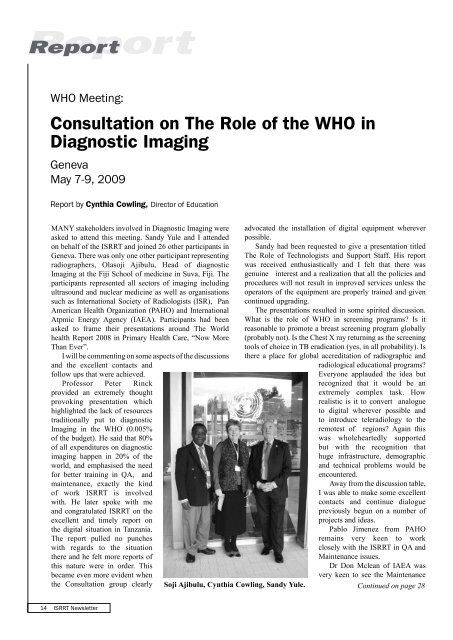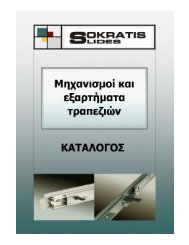isrrt Newsletter Volume 45. No.2 - 2009
Create successful ePaper yourself
Turn your PDF publications into a flip-book with our unique Google optimized e-Paper software.
Report<br />
WHO Meeting:<br />
Consultation on The Role of the WHO in<br />
Diagnostic Imaging<br />
Geneva<br />
May 7-9, <strong>2009</strong><br />
Report by Cynthia Cowling, Director of Education<br />
Many stakeholders involved in Diagnostic Imaging were<br />
asked to attend this meeting. Sandy Yule and I attended<br />
on behalf of the ISRRT and joined 26 other participants in<br />
Geneva. There was only one other participant representing<br />
radiographers, Olasoji Ajibulu, Head of diagnostic<br />
Imaging at the Fiji School of medicine in Suva, Fiji. The<br />
participants represented all sectors of imaging including<br />
ultrasound and nuclear medicine as well as organisations<br />
such as International Society of Radiologists (ISR), Pan<br />
American Health Organization (PAHO) and International<br />
Atpmic Energy Agency (IAEA). Participants had been<br />
asked to frame their presentations around The World<br />
health Report 2008 in Primary Health Care, “Now More<br />
Than Ever”.<br />
I will be commenting on some aspects of the discussions<br />
and the excellent contacts and<br />
follow ups that were achieved.<br />
Professor Peter Rinck<br />
provided an extremely thought<br />
provoking presentation which<br />
highlighted the lack of resources<br />
traditionally put to diagnostic<br />
Imaging in the WHO (0.005%<br />
of the budget). He said that 80%<br />
of all expenditures on diagnostic<br />
imaging happen in 20% of the<br />
world, and emphasised the need<br />
for better training in QA, and<br />
maintenance, exactly the kind<br />
of work ISRRT is involved<br />
with. He later spoke with me<br />
and congratulated ISRRT on the<br />
excellent and timely report on<br />
the digital situation in Tanzania.<br />
The report pulled no punches<br />
with regards to the situation<br />
there and he felt more reports of<br />
this nature were in order. This<br />
became even more evident when<br />
the Consultation group clearly<br />
Soji Ajibulu, Cynthia Cowling, Sandy Yule.<br />
advocated the installation of digital equipment wherever<br />
possible.<br />
Sandy had been requested to give a presentation titled<br />
The Role of Technologists and Support Staff. His report<br />
was received enthusiastically and I felt that there was<br />
genuine interest and a realization that all the policies and<br />
procedures will not result in improved services unless the<br />
operators of the equipment are properly trained and given<br />
continued upgrading.<br />
The presentations resulted in some spirited discussion.<br />
What is the role of WHO in screening programs? Is it<br />
reasonable to promote a breast screening program globally<br />
(probably not). Is the Chest X ray returning as the screening<br />
tools of choice in TB eradication (yes, in all probability). Is<br />
there a place for global accreditation of radiographic and<br />
radiological educational programs?<br />
Everyone applauded the idea but<br />
recognized that it would be an<br />
extremely complex task. How<br />
realistic is it to convert analogue<br />
to digital wherever possible and<br />
to introduce teleradiology to the<br />
remotest of regions? Again this<br />
was wholeheartedly supported<br />
but with the recognition that<br />
huge infrastructure, demographic<br />
and technical problems would be<br />
encountered.<br />
Away from the discussion table,<br />
I was able to make some excellent<br />
contacts and continue dialogue<br />
previously begun on a number of<br />
projects and ideas.<br />
Pablo Jimenez from PAHO<br />
remains very keen to work<br />
closely with the ISRRT in QA and<br />
Maintenance issues.<br />
Dr Don Mclean of IAEA was<br />
very keen to see the Maintenance<br />
Continued on page 28<br />
14 ISRRT <strong>Newsletter</strong>

















